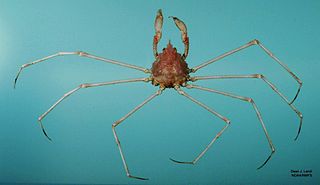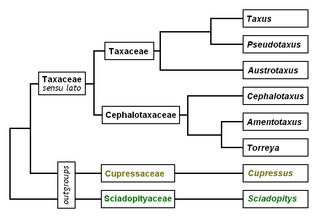
Taxus is a genus of coniferous trees or shrubs known as yews in the family Taxaceae. They are relatively slow-growing and can be very long-lived, and reach heights of 2.5–20 metres (8.2–65.6 ft), with trunk girth averaging 5 metres (16 ft). They have reddish bark, lanceolate, flat, dark-green leaves 10–40 millimetres long and 2–3 mm broad, arranged spirally on the stem, but with the leaf bases twisted to align the leaves in two flat rows either side of the stem.

Castanopsis, commonly called chinquapin or chinkapin, is a genus of evergreen trees belonging to the beech family, Fagaceae. The genus contains about 120 species, which are today restricted to tropical and subtropical eastern Asia. A total of 58 species are native to China, with 30 endemic; the other species occur further south, through Indochina to Indonesia, mountainous areas of Taiwan, and also in Japan. The English name chinkapin is shared with other related plants, including the golden chinkapins of the Pacific United States, which are sometimes included within Castanopsis but are more often considered a separate but very closely related genus, Chrysolepis.

Oryzopsis hymenoides is a perennial cool-season bunchgrass with very narrow, rolled leaf blades. It is native to western North America east of the Cascades from British Columbia and Alberta south to southern California, northeastern Mexico, and Texas. In the wild, it typically grows 4 to 24 in tall and 8 to 12 in wide.

Castanopsis cuspidata is a species of Castanopsis native to southern Japan and southern Korea.
Alsophila cuspidata, synonym Cyathea cuspidata, is a widespread species of tree fern native to Central and South America, where it grows in tropical rain forest up to the montane zone, as well as in open sites, on riverbanks and cleared pastureland at an altitude of 0–800 m. Its natural distribution covers Mexico, Guatemala, Belize, Honduras, El Salvador, Nicaragua, Costa Rica, Panama, Colombia, Ecuador, Peru, Bolivia, Paraguay, the Amazon Basin, Brazil and French Guiana. This species often has multiple trunks, which may be 15 m tall and about 10 cm in diameter. They are covered in black spines and together form a medium-sized, feathery clump. Fronds are bipinnate and 2–3 m long. The rachis and stipe are brown to dark brown and are covered with scales. The scales are bicoloured, having a dark brown to blackish centre and a pale, whitish margin. Pinnule veins sometimes have small, brown, star-shaped scales. Sori are round and form on either side of the pinnule midvein. They are covered by globose indusia.
The knifetooth sawfish, also known as the pointed sawfish or narrow sawfish, is a species of sawfish in the family Pristidae, part of the Batoidea, a superorder of cartilaginous fish that includes the rays and skates. Sawfish display a circumglobal distribution in warm marine and freshwater habitats. Their extant biodiversity is limited to five species belonging to two genera. The sawfishes are characterised by the long, narrow, flattened rostrum or extension on their snout. This is lined with sharp transverse teeth, arranged in a way that resembles the teeth of a saw. It is found in the shallow coastal waters and estuaries of the Indo-West Pacific, ranging from the Red Sea and the Persian Gulf to southern Japan, Papua New Guinea and northern Australia. It is the only living member of the genus Anoxypristis, but was previously included in the genus Pristis. Compared to that genus, Anoxypristis has a narrower rostral saw with numerous teeth on the distal part and no teeth on the basal one-quarter. This endangered species reaches a length of up to 3.5 m (11.5 ft).

Carcharias is a genus of sand tiger sharks belonging to the family Odontaspididae.
Gulella cuspidata is a species of very small air-breathing land snails, terrestrial pulmonate gastropod mollusks in the family Streptaxidae.
Malmea is a genus of plant in family Annonaceae. It contains the following species :
Shorea cuspidata is a species of plant in the Dipterocarpaceae family. It is endemic to Sarawak, Malaysia. It is incorrectly listed on the IUCN Red List as extinct, however populations are known to occur in the Bako and Lambir Hills.

Chorizanthe cuspidata is a species of flowering plant in the buckwheat family known by the common name San Francisco spineflower. It is endemic to California, where it is known only from the San Francisco Bay Area and to the immediate north and south. It grows in sandy coastal habitat.
Hastula cuspidata is a species of sea snail, a marine gastropod mollusk in the family Terebridae, the auger snails.
C. cuspidata may refer to:
T. cuspidata may refer to:

Muhlenbergia cuspidata is a species of grass known by the common name plains muhly. It is native to North America where it is distributed across central Canada and the central United States.

Pyromaia cuspidata, also known as the dartnose pear crab, is a species of crab in the family Inachoididae. This crab appears similar to Anasimus latus. It is a long-legged crab with a trident-shaped rostrum, and occurs in Atlantic waters from North Carolina to west Florida, and in the Gulf of Mexico through the Yucatán Peninsula down to Nicaragua. It is also found in Cuban waters. This species lives in depths of 27–549 metres (89–1,801 ft) on bottoms of mud, sand, or pebbles.

Yew is a common name given to various species of trees.

Doto cuspidata is a species of sea slug, a dendronotid nudibranch, a marine gastropod mollusc in the family Dotidae.
Tabernaemontana cuspidata is a species of plant in the family Apocynaceae. It is found in northwestern South America.

Camellia cuspidata is a species of Camellia from China.











